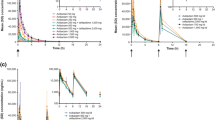Abstract
In vitro studies on the activity of cefprozil have been conducted in Europe and North America. Against gram-negative bacilli, cefprozil and cefaclor are at least two to four times more active than cephalexin. Cefixime is more active against these organisms. Against gram-positive cocci, cefprozil is at least two to four times more active than cefaclor and cephalexin; cefixime has limited gram-positive activity, and is particularly inactive against staphylococci (MIC90 32 mg/l). Cefprozil is highly active againstStreptococcus pneumoniae (unlike cefixime). Those strains of this genus that display intermediate resistance to pneumococci are more susceptible to cefprozil than cefaclor.Neisseria species andMoraxella catarrhalis are susceptible to cefprozil (MIC90 0.06 and 1 mg/l). β-lactamase-producing strains ofHaemophilus influenzae appear to be susceptible to cefprozil, as the reported MIC90 is 2–4 mg/I. Enterococci,Pseudomonas aeruginosa, and those strains of theEnterobacteriaceae that commonly possess a chromosomal cephalosporinase (e.g.,Providencia, Morganella andEnterobacter) are generally considered to be resistant to cefprozil as well as to other oral cephalosporins. Cefprozil appears to display enhanced stability to the commonly encountered Tem-1 and SHV-1 plasmid-mediated β-lactamases, as found inHaemophilus influenzae, Neisseria gonorrhoeae and theEnterobacteriaceae. Cefprozil is rapidly absorbed, reaching a maximum concentration 0.9 to 1.2 h post-dose. Following oral doses of 250 and 500 mg, the Cmax is 6.2 and 10.0 mg/l respectively. Serum half-lives are generally reported as between 1.2 and 1.4 h, and urine recovery is high, 57–70 %. Ingestion of food has no significant effect on cefprozil pharmacokinetics, but does reduce the serum levels of cefaclor. Studies in severe renal dysfunction suggest that only when the creatinine clearance is under 30 ml/min (when the half-life exceeds 5 h) is there a need for a reduction in the dosage of cefprozil by 50 % or an increase of the dosage interval. Children (over 2 months of age) have very similar pharmacokinetics, the only difference being a slightly shorter cefprozil half-life (ca. 1.0 h). Studies in the elderly suggest that age, per se, does not need an alteration in dosing. The tissue penetration of cefprozil is similar to that of other β-lactams and the blister-fluid model demonstrates that 80 % penetration is found in an inflammatory exudate.
Similar content being viewed by others
References
Chin N-X, Neu HC: Comparative antibacterial activity of a new oral cephalosporin, BMY 28100. Antimicrobial Agents and Chemotherapy 1987, 31: 480–483.
Hiraoka M, Masuyoshi S, Tomatsu K: In vitro activity and β-lactamase stability of the oral cephalosporin BMY 28100. European Journal of Clinical Microbiology 1987, 6: 559–563.
Jones RN, Barry AL: BMY 28100, a new oral cephalosporin: antimicrobial activity against nearly 7000 recent clinical isolates. Diagnostic Microbiology and Infectious Diseases 1988, 9: 11–26.
Leitner E, Pursiano PA, Buck RE: BMY 28100, a new oral cephalosporin. Antimicrobial Agents and Chemotherapy 1987, 31: 238–243.
Kayser F: Comparative antibacterial activity of a new oral cephalosporin BMY 28100. European Journal of Clinical Microbiology 1987, 6: 309–312.
Steele J, Edwards B, Rissling J: In vitro activity of BMY 28100, a new oral cephalosporin. European Journal of Clinical Microbiology 1987, 6: 111–113.
Thornsberry C: Review of the in vitro antibacterial activity of cefprozil, a new oral cephalosporin. Clinical Infectious Diseases 1992, 14: Supplement 2: 189–194.
Kitzis MD, Liassine N, Ferre B, Gutman L, Acar JF, Goldstein F: In vitro activities of 15 oral β-lactams againstKlebsiella pneumoniae harboring new extended spectrum β-lactamases. Antimicrobial Agents and Chemotherapy 1990, 34: 1783–1786.
Tomatsu K, Ando S, Masuyoshi S, Kondo S, Kawaguchi H: In vitro and in vivo evaluation of BMY 28100, a new oral cephalosporin. Journal of Antibiotics 1987, 40: 1175–1183.
Jolly A, Andrews JM, Brenwald N, Wise R: The in vitro activity of a new highly active quinolone, DU-6859a. Journal of Antimicrobial Chemotherapy 1993, 32: 757–763.
Lode H, Muller C, Borner K, Nord C-E, Koeppe P: Multi-dose pharmacokinetics of cefprozil and its effects on intestinal flora of volunteers. Antimicrobial Agents and Chemotherapy 1992, 36: 144–149.
Barbhaiya RH, Shukla UA, Gleason CR, Shuya WC, Pittman KA: Comparison of the effects of food on the pharmacokinetics of cefprozil and cefaclor. Antimicrobial Agents and Chemotherapy 1990, 34: 1210–1213.
Shyu WC, Wilber RB, Pittman KA, Barbhaiya RH: Effect of antacid on the bioavailability of cefprozil. Antimicrobial Agents and Chemotherapy 1992, 36: 962–965.
Shyu WC, Pittman KA, Wilber RB, Matzke GR, Barbhaiya RH: Pharmacokinetics of cefprozil in healthy subjects and patients with renal impairment. Journal of Clinical Pharmacology 1991, 31: 362–371.
Shyu WC, Wilber RB, Pittman KA, Garg DC, Barbhaiya RH: Pharmacokinectic of cefprozil in healthy subjects and patients with hepatic impairment. Journal of Clinical Pharmacology 1991, 31: 373–376.
Saez-Liorens X, Shyu WC, Shelton S, Kumiesz H, Nelson J: Pharmacokinetics of cefprozil in infants and children. Antimicrobial Agents and Chemotherapy 1990, 34: 372–376.
Nye K, O'Neill P, Andrews JM, Wise R: Pharmacokinetics and tissue penetration of cefprozil. Journal of Antimicrobial Chemotherapy 1990, 25: 831–835.
Author information
Authors and Affiliations
Rights and permissions
About this article
Cite this article
Wise, R. Comparative microbiological activity and pharmacokinetics of cefprozil. Eur. J. Clin. Microbiol. Infect. Dis. 13, 839–845 (1994). https://doi.org/10.1007/BF02111350
Issue Date:
DOI: https://doi.org/10.1007/BF02111350



